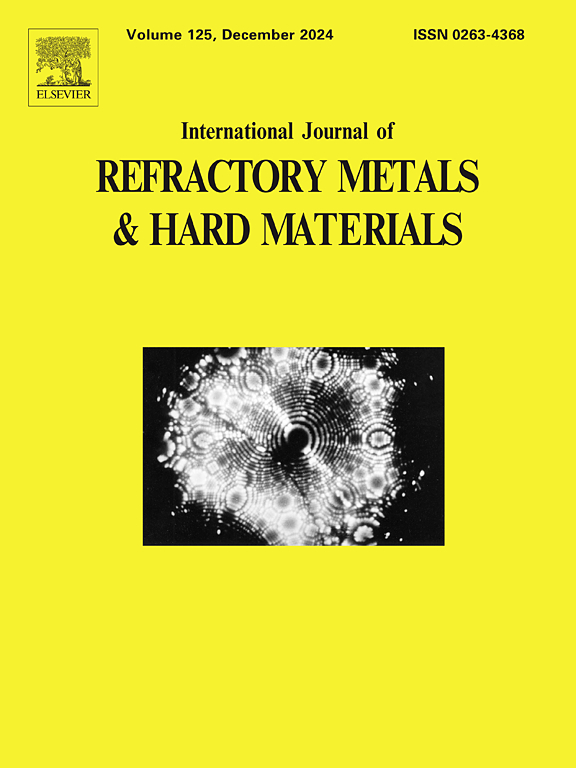The influence of ball milling conditions on the powder characteristics and sintering densification of MoCu alloy
IF 4.2
2区 材料科学
Q2 MATERIALS SCIENCE, MULTIDISCIPLINARY
International Journal of Refractory Metals & Hard Materials
Pub Date : 2024-10-09
DOI:10.1016/j.ijrmhm.2024.106914
引用次数: 0
Abstract
Mechanical alloying was utilized to produce Mo-30Cu(wt%) composite powder. The effects of milling conditions on the powder characteristics and sintering densification were investigated. The morphological evolution during the mechanical alloying process can be categorized into four stages: 1-individual Mo and Cu particles, 2-coexistence of Mo particles and blocky Mo![]() Cu composite particles, 3-coarse irregular composite particles, and 4-refined near-spherical composite particles or lamellar Mo
Cu composite particles, 3-coarse irregular composite particles, and 4-refined near-spherical composite particles or lamellar Mo![]() Cu composite particles, depending on whether process control agent (PCA) is added. The mechanical alloying degree of the Mo
Cu composite particles, depending on whether process control agent (PCA) is added. The mechanical alloying degree of the Mo![]() Cu composite powder was deepened gradually from stage 1 to 4, which is influenced by the ball milling parameters. As the milling speed and milling time increase, the lattice strain and the alloying degree of the Mo
Cu composite powder was deepened gradually from stage 1 to 4, which is influenced by the ball milling parameters. As the milling speed and milling time increase, the lattice strain and the alloying degree of the Mo![]() Cu composite powders increase while the grain size of molybdenum particles decreases, which is conducive to accelerating the sintering density. Among these ball milling parameters, an elevated milling speed notably accelerates the mechanical alloying process and the sintering density. Under the milling speed of 600 r/min, ball to powder ratio (BPR) of 10:1, and milling time of 4 h, the grain size, lattice strain, and average particle diameter of the composite powder were measured to be 48.4 nm, 0.247 %, and 21.04 μm, respectively, with the particle morphology being nearly spherical. The sintered density of the Mo
Cu composite powders increase while the grain size of molybdenum particles decreases, which is conducive to accelerating the sintering density. Among these ball milling parameters, an elevated milling speed notably accelerates the mechanical alloying process and the sintering density. Under the milling speed of 600 r/min, ball to powder ratio (BPR) of 10:1, and milling time of 4 h, the grain size, lattice strain, and average particle diameter of the composite powder were measured to be 48.4 nm, 0.247 %, and 21.04 μm, respectively, with the particle morphology being nearly spherical. The sintered density of the Mo![]() Cu composite reached 98.1 %, larger than the other composites.
Cu composite reached 98.1 %, larger than the other composites.
球磨条件对 MoCu 合金粉末特性和烧结致密化的影响
利用机械合金化技术生产了 Mo-30Cu(wt%) 复合粉末。研究了研磨条件对粉末特性和烧结致密化的影响。机械合金化过程中的形态演变可分为四个阶段:1-单独的 Mo 和 Cu 颗粒;2-Mo 颗粒和块状 MoCu 复合颗粒共存;3-粗大的不规则复合颗粒;4-精制的近球形复合颗粒或片状 MoCu 复合颗粒(取决于是否添加工艺控制剂 (PCA))。MoCu 复合粉末的机械合金化程度从第 1 阶段到第 4 阶段逐渐加深,这主要受球磨参数的影响。随着球磨速度和球磨时间的增加,MoCu 复合粉末的晶格应变和合金化程度增加,而钼颗粒的粒度减小,这有利于加快烧结密度。在这些球磨参数中,提高球磨速度明显加快了机械合金化过程和烧结密度。在球磨速度为 600 r/min、球粉比(BPR)为 10:1 和球磨时间为 4 h 的条件下,测得复合粉末的晶粒尺寸、晶格应变和平均颗粒直径分别为 48.4 nm、0.247 % 和 21.04 μm,颗粒形态接近球形。MoCu 复合材料的烧结密度达到 98.1%,大于其他复合材料。
本文章由计算机程序翻译,如有差异,请以英文原文为准。
求助全文
约1分钟内获得全文
求助全文
来源期刊
CiteScore
7.00
自引率
13.90%
发文量
236
审稿时长
35 days
期刊介绍:
The International Journal of Refractory Metals and Hard Materials (IJRMHM) publishes original research articles concerned with all aspects of refractory metals and hard materials. Refractory metals are defined as metals with melting points higher than 1800 °C. These are tungsten, molybdenum, chromium, tantalum, niobium, hafnium, and rhenium, as well as many compounds and alloys based thereupon. Hard materials that are included in the scope of this journal are defined as materials with hardness values higher than 1000 kg/mm2, primarily intended for applications as manufacturing tools or wear resistant components in mechanical systems. Thus they encompass carbides, nitrides and borides of metals, and related compounds. A special focus of this journal is put on the family of hardmetals, which is also known as cemented tungsten carbide, and cermets which are based on titanium carbide and carbonitrides with or without a metal binder. Ceramics and superhard materials including diamond and cubic boron nitride may also be accepted provided the subject material is presented as hard materials as defined above.

 求助内容:
求助内容: 应助结果提醒方式:
应助结果提醒方式:


